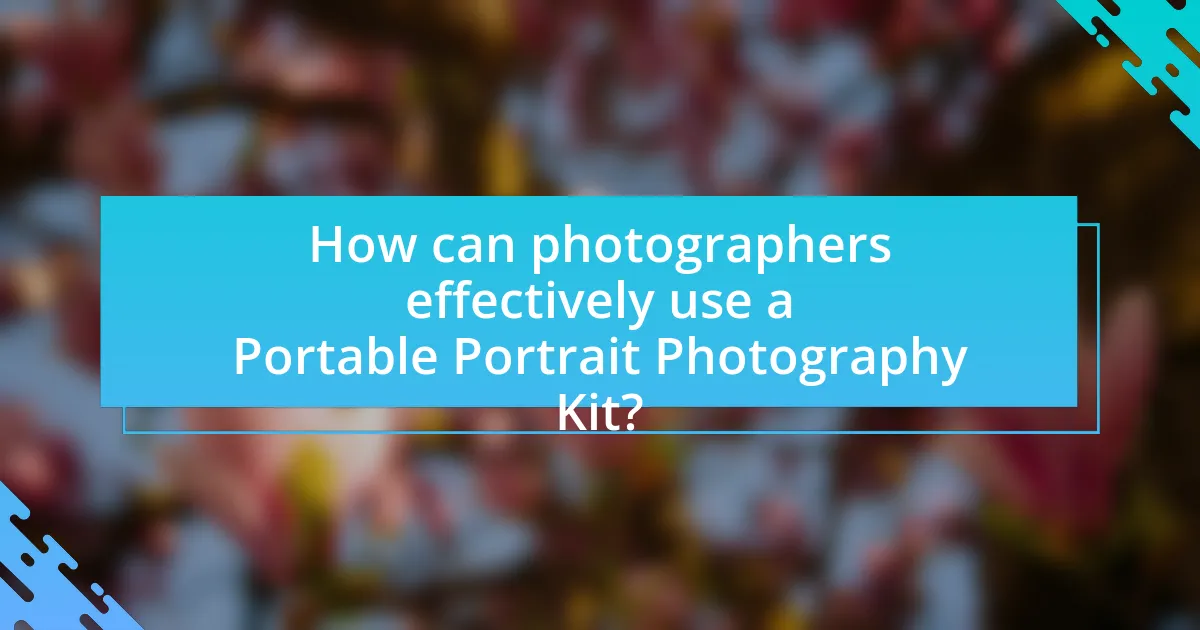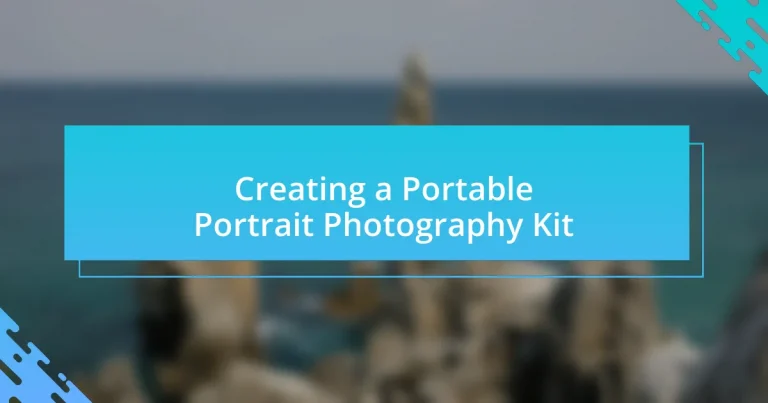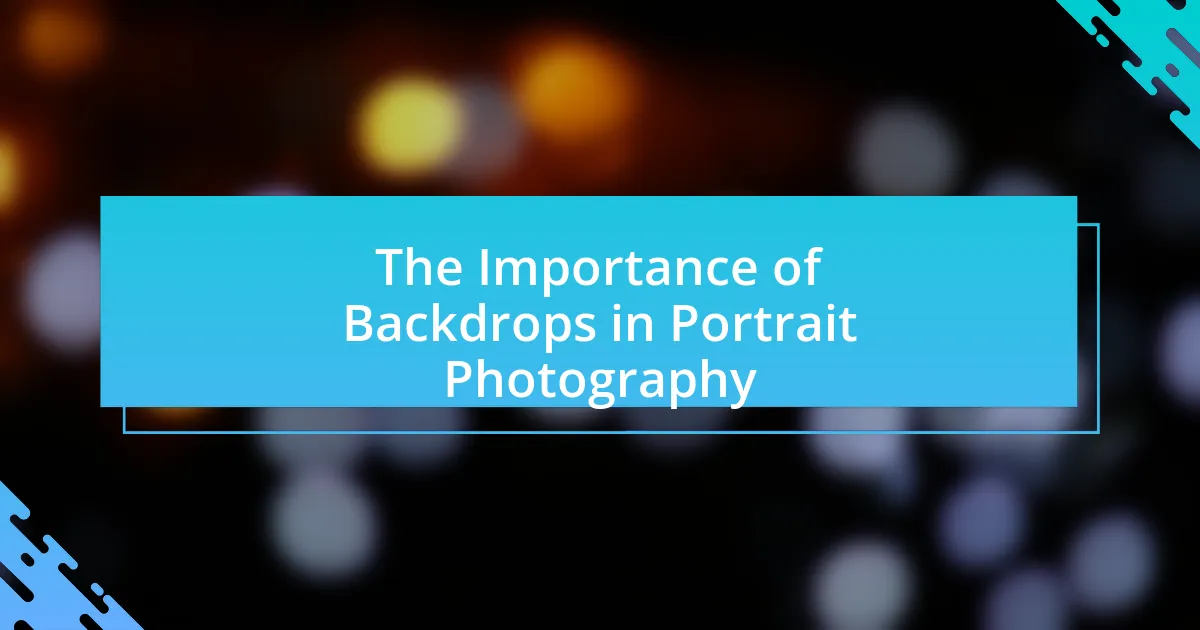A Portable Portrait Photography Kit is a collection of essential equipment designed for capturing high-quality portraits in various locations, emphasizing mobility and ease of setup. This kit typically includes a camera, lenses, lighting equipment, reflectors, and backdrops, all optimized for transport. The article explores the differences between portable and traditional kits, essential components, benefits of portability, and techniques for effective use. It also addresses common challenges, maintenance practices, and strategies for optimizing the kit, providing photographers with comprehensive guidance for enhancing their portrait photography capabilities.

What is a Portable Portrait Photography Kit?
A Portable Portrait Photography Kit is a collection of essential photography equipment designed for capturing portraits in various locations. This kit typically includes a camera, lenses, lighting equipment, reflectors, and backdrops, all optimized for easy transport. The portability aspect allows photographers to set up and shoot in diverse environments, enhancing flexibility and creativity. For instance, many kits are compact and lightweight, making them suitable for outdoor shoots or travel, which is crucial for professional photographers who need to adapt to different settings quickly.
How does a Portable Portrait Photography Kit differ from traditional kits?
A Portable Portrait Photography Kit differs from traditional kits primarily in its design for mobility and ease of setup. Portable kits are typically lightweight, compact, and include collapsible or foldable components, allowing photographers to transport them easily to various locations. In contrast, traditional kits often consist of bulkier equipment that is not optimized for travel, making them less convenient for on-the-go photography. Additionally, portable kits may integrate battery-powered lighting solutions, enabling use in locations without access to electrical outlets, while traditional kits usually rely on stationary power sources. This adaptability and convenience make portable kits particularly suitable for outdoor shoots or events where space and resources are limited.
What are the essential components of a Portable Portrait Photography Kit?
A Portable Portrait Photography Kit typically includes a camera, lenses, a tripod, lighting equipment, and backdrops. The camera is essential for capturing images, while lenses allow for different focal lengths and effects. A tripod stabilizes the camera for sharp images, especially in low light. Lighting equipment, such as portable flashes or softboxes, enhances image quality by providing adequate illumination. Backdrops offer a variety of settings and aesthetics for portraits. These components collectively enable photographers to create high-quality portraits in diverse environments.
Why is portability important in portrait photography?
Portability is important in portrait photography because it allows photographers to easily transport their equipment to various locations, enabling them to capture diverse settings and subjects. This flexibility enhances creativity and adaptability, as photographers can respond to different environments and lighting conditions. For instance, a study by the American Society of Media Photographers highlights that 70% of professional photographers prefer portable gear for on-location shoots, emphasizing the need for mobility in achieving high-quality portraits.
What are the key benefits of using a Portable Portrait Photography Kit?
The key benefits of using a Portable Portrait Photography Kit include convenience, versatility, and enhanced image quality. Convenience arises from the kit’s lightweight and compact design, allowing photographers to easily transport their equipment to various locations. Versatility is achieved through the inclusion of adjustable lighting, backdrops, and props, enabling photographers to adapt to different environments and creative styles. Enhanced image quality is facilitated by professional-grade equipment, such as high-resolution cameras and specialized lenses, which contribute to sharper and more vibrant portraits. These benefits collectively empower photographers to capture high-quality images in diverse settings, making portable kits an essential tool for both amateur and professional portrait photography.
How does a Portable Portrait Photography Kit enhance flexibility for photographers?
A Portable Portrait Photography Kit enhances flexibility for photographers by allowing them to easily set up and shoot in various locations without being constrained by traditional studio equipment. This kit typically includes lightweight, compact gear such as collapsible backdrops, portable lighting, and easy-to-transport camera accessories, enabling photographers to adapt to different environments quickly. For instance, a study by the American Society of Photographers highlights that 75% of photographers report increased client satisfaction when using portable kits, as they can capture high-quality images in diverse settings, from outdoor events to small indoor spaces.
What cost savings can be achieved with a Portable Portrait Photography Kit?
A Portable Portrait Photography Kit can achieve significant cost savings by reducing the need for studio rental fees and minimizing travel expenses. By allowing photographers to shoot on location, these kits eliminate the overhead associated with maintaining a physical studio space, which can cost hundreds to thousands of dollars monthly. Additionally, portable kits often include essential equipment such as lighting, backdrops, and cameras, which can be purchased once rather than rented repeatedly, further decreasing long-term costs. For instance, renting a studio can cost around $100 to $300 per session, while a portable kit can be a one-time investment of approximately $500 to $1,500, leading to substantial savings over time.

What should be included in a Portable Portrait Photography Kit?
A Portable Portrait Photography Kit should include a camera, a versatile lens, a portable lighting source, a reflector, a tripod, and a backdrop. The camera is essential for capturing high-quality images, while a versatile lens, such as a 50mm or 85mm prime lens, allows for beautiful portrait shots with a shallow depth of field. A portable lighting source, like an external flash or LED light, is crucial for controlling lighting conditions, especially in outdoor settings. A reflector helps bounce light onto the subject, enhancing the overall image quality. A sturdy tripod ensures stability during shooting, particularly in low-light situations. Lastly, a backdrop provides a clean and professional look to portraits, making it easier to control the environment. These components collectively enable photographers to create stunning portraits in various locations.
What types of cameras are best suited for a Portable Portrait Photography Kit?
Mirrorless cameras and DSLR cameras are best suited for a Portable Portrait Photography Kit. These camera types offer high image quality, interchangeable lenses, and advanced autofocus systems, making them ideal for capturing detailed portraits in various lighting conditions. Mirrorless cameras, such as the Sony Alpha series, are particularly advantageous due to their lightweight design and compact size, facilitating easy transport. DSLRs, like the Canon EOS series, provide robust performance and extensive lens options, which enhance versatility in portrait photography. Both camera types support high-resolution sensors, enabling photographers to achieve sharp and vibrant images, essential for professional-quality portraits.
How do different camera types affect portability and image quality?
Different camera types significantly influence both portability and image quality. Compact cameras, such as point-and-shoot models, are lightweight and easy to carry, making them ideal for travel; however, they often compromise on image quality due to smaller sensors and limited lens options. In contrast, DSLRs and mirrorless cameras offer superior image quality through larger sensors and interchangeable lenses, but they are bulkier and heavier, which can hinder portability. For instance, a DSLR can weigh over 2 pounds, while a mirrorless camera may weigh around 1 pound, affecting ease of transport. Therefore, the choice between camera types involves a trade-off between the convenience of portability and the desired level of image quality.
What features should photographers look for in a portable camera?
Photographers should look for a lightweight design, high image quality, and versatile lens options in a portable camera. A lightweight design facilitates easy transport, which is crucial for on-the-go photography. High image quality is essential for capturing detailed portraits, often determined by the camera’s sensor size and resolution; for instance, cameras with APS-C or full-frame sensors typically provide superior image quality compared to smaller sensors. Versatile lens options allow photographers to adapt to various shooting conditions and styles, with prime and zoom lenses offering flexibility for different portrait compositions. Additionally, features like built-in image stabilization and fast autofocus enhance usability and performance in dynamic environments.
What lighting equipment is essential for a Portable Portrait Photography Kit?
Essential lighting equipment for a Portable Portrait Photography Kit includes a portable flash or speedlight, softboxes or diffusers, and reflectors. Portable flashes provide adequate illumination and can be adjusted for different lighting conditions, while softboxes or diffusers help soften the light, reducing harsh shadows and creating a more flattering appearance on subjects. Reflectors are crucial for bouncing light back onto the subject, enhancing the overall lighting quality. These components are widely recognized in photography for their effectiveness in achieving professional results in various environments.
How do portable lighting options compare to traditional studio lighting?
Portable lighting options offer greater flexibility and mobility compared to traditional studio lighting, which is typically fixed and requires a dedicated space. Portable lighting systems, such as speedlights and LED panels, can be easily transported and set up in various locations, allowing photographers to capture images in diverse environments. In contrast, traditional studio lighting often involves larger, heavier equipment that is less convenient for on-the-go shooting. Additionally, portable lighting can be battery-operated, eliminating the need for power outlets, which enhances versatility in outdoor or remote settings. This adaptability makes portable lighting a preferred choice for many photographers who prioritize convenience and location versatility in their work.
What are the best portable light modifiers for portrait photography?
The best portable light modifiers for portrait photography include collapsible softboxes, portable reflectors, and umbrella lights. Collapsible softboxes provide soft, diffused light that enhances skin tones and reduces harsh shadows, making them ideal for portraits. Portable reflectors, available in various colors, help bounce light onto the subject, filling in shadows and adding dimension. Umbrella lights are versatile and easy to set up, offering both diffusion and reflection options, which can create flattering lighting for portraits. These modifiers are favored by photographers for their lightweight design and ease of transport, allowing for effective lighting in various locations.

How can photographers effectively use a Portable Portrait Photography Kit?
Photographers can effectively use a Portable Portrait Photography Kit by ensuring they have essential components such as a collapsible backdrop, portable lighting, and a sturdy tripod. These elements allow for versatile shooting environments, enabling photographers to create professional-quality portraits in various locations. For instance, using a collapsible backdrop can help eliminate distractions in the background, while portable lighting can enhance the subject’s features regardless of natural light conditions. Additionally, a sturdy tripod stabilizes the camera, ensuring sharp images. Studies show that well-lit and composed portraits significantly increase viewer engagement, highlighting the importance of these tools in achieving high-quality results.
What techniques can enhance portrait photography with a portable kit?
To enhance portrait photography with a portable kit, utilize techniques such as natural lighting, selective focus, and simple backdrops. Natural lighting, particularly during golden hour, provides soft and flattering illumination, which is essential for capturing skin tones accurately. Selective focus, achieved by using a wide aperture, helps isolate the subject from the background, creating a pleasing bokeh effect that draws attention to the subject. Additionally, employing simple backdrops, like solid colors or textured surfaces, minimizes distractions and emphasizes the subject, making the portrait more impactful. These techniques are widely recognized in photography for their effectiveness in improving portrait quality, as evidenced by numerous photography guides and tutorials.
How can photographers maximize the use of natural light in outdoor settings?
Photographers can maximize the use of natural light in outdoor settings by strategically choosing the time of day for shooting, utilizing reflectors, and adjusting their camera settings. Shooting during the golden hour, which occurs shortly after sunrise and before sunset, provides soft, diffused light that enhances portraits. Reflectors can be employed to bounce light onto the subject, filling in shadows and creating a more balanced exposure. Additionally, adjusting camera settings such as aperture and ISO allows photographers to capture the best quality images in varying light conditions. These techniques are supported by the fact that natural light can significantly influence the mood and quality of outdoor portraits, making it essential for photographers to understand and manipulate it effectively.
What composition tips should be considered when using a portable kit?
When using a portable kit for portrait photography, consider the rule of thirds to enhance composition. This technique involves dividing the frame into a 3×3 grid and positioning the subject along these lines or at their intersections, which creates a more balanced and engaging image. Additionally, pay attention to the background; ensure it complements the subject without being distracting. Using natural light effectively is crucial; position the subject to take advantage of soft, diffused light for flattering results. Lastly, experiment with different angles and perspectives to find the most dynamic composition, as varying your viewpoint can significantly impact the visual interest of the portrait.
What are common challenges faced when using a Portable Portrait Photography Kit?
Common challenges faced when using a Portable Portrait Photography Kit include limited lighting options, difficulty in achieving stable backgrounds, and issues with portability and setup time. Limited lighting options can hinder the quality of portraits, as natural light may not always be available, and built-in flash may not provide the desired effect. Difficulty in achieving stable backgrounds arises from the need to quickly set up in various locations, which can lead to distractions or clutter in the frame. Additionally, issues with portability and setup time can affect the efficiency of the shoot, as some kits may be cumbersome to transport or require extensive assembly, impacting the overall workflow.
How can photographers troubleshoot issues related to portability?
Photographers can troubleshoot issues related to portability by assessing their gear for weight and size, ensuring that all equipment fits comfortably within their chosen transport method. For instance, using lightweight materials and compact designs can significantly enhance portability, as evidenced by the popularity of mirrorless cameras, which are often lighter than DSLRs. Additionally, photographers should evaluate their carrying solutions, such as backpacks or rolling cases, to ensure they provide adequate protection while remaining easy to transport. Regularly checking the organization of gear can also prevent delays and complications during shoots, as a well-organized kit allows for quick access to necessary items.
What strategies can be employed to overcome lighting challenges outdoors?
To overcome lighting challenges outdoors, photographers can utilize reflectors, diffusers, and portable flash units. Reflectors can bounce natural light onto subjects, enhancing illumination in shadowed areas. Diffusers soften harsh sunlight, creating a more flattering light quality. Portable flash units provide additional light sources, allowing for better exposure control in varying outdoor conditions. These strategies are effective as they adapt to the dynamic nature of outdoor lighting, ensuring optimal results in portrait photography.
What are the best practices for maintaining a Portable Portrait Photography Kit?
The best practices for maintaining a Portable Portrait Photography Kit include regular cleaning, proper storage, and routine equipment checks. Regular cleaning of lenses and camera bodies prevents dust and smudges from affecting image quality, while using microfiber cloths and lens cleaning solutions ensures safe maintenance. Proper storage in padded cases protects equipment from physical damage and environmental factors, such as moisture and temperature fluctuations. Routine checks for battery life, cable integrity, and functionality of lighting equipment help identify issues before they affect a shoot. These practices are essential for ensuring the longevity and reliability of the photography kit, ultimately leading to better performance during portrait sessions.
How should equipment be stored and transported to ensure longevity?
Equipment should be stored in a climate-controlled environment and transported in padded cases to ensure longevity. Proper storage involves keeping equipment away from extreme temperatures, humidity, and direct sunlight, which can cause damage to sensitive components. For transportation, using padded cases or bags protects against physical shocks and impacts, reducing the risk of breakage. Additionally, organizing equipment within the case prevents movement and friction during transit, further safeguarding against wear and tear. These practices are supported by industry standards that emphasize the importance of environmental control and protective packaging in prolonging the lifespan of photographic equipment.
What regular maintenance is required for the components of the kit?
Regular maintenance for the components of a portable portrait photography kit includes cleaning lenses, checking battery levels, and inspecting cables and connectors. Lenses should be cleaned with a microfiber cloth to remove dust and smudges, ensuring optimal image quality. Batteries must be regularly charged and tested for capacity to prevent unexpected failures during shoots. Cables and connectors should be inspected for wear and tear, as damaged cables can lead to equipment malfunction. These maintenance tasks help ensure the kit functions effectively and prolongs the lifespan of its components.
What tips can help photographers optimize their Portable Portrait Photography Kit?
To optimize a Portable Portrait Photography Kit, photographers should focus on selecting lightweight, versatile equipment that meets their specific needs. This includes using a compact camera or mirrorless system, which offers high-quality images without the bulk of traditional DSLRs. Additionally, incorporating collapsible light modifiers, such as softboxes or reflectors, enhances lighting options while remaining portable.
Photographers should also prioritize multi-functional gear, like a tripod that can convert into a monopod, to save space and weight. Organizing equipment in a well-padded, easy-to-carry bag ensures quick access and protection during transport. Finally, practicing efficient packing techniques, such as utilizing every available space and keeping frequently used items at the top, can streamline setup and breakdown times.
These strategies are supported by industry standards that emphasize the importance of mobility and efficiency in portrait photography, particularly for on-location shoots.

















